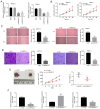Silencing of long non-coding RNA SNHG15 suppresses proliferation, migration and invasion of pancreatic cancer cells by regulating the microRNA-345-5p/RAB27B axis
- PMID: 34594410
- PMCID: PMC8456484
- DOI: 10.3892/etm.2021.10708
Silencing of long non-coding RNA SNHG15 suppresses proliferation, migration and invasion of pancreatic cancer cells by regulating the microRNA-345-5p/RAB27B axis
Retraction in
-
[Retracted] Silencing of long non-coding RNA SNHG15 suppresses proliferation, migration and invasion of pancreatic cancer cells by regulating the microRNA-345-5p/RAB27B axis.Exp Ther Med. 2025 Jul 7;30(3):169. doi: 10.3892/etm.2025.12919. eCollection 2025 Sep. Exp Ther Med. 2025. PMID: 40692767 Free PMC article.
Abstract
Pancreatic cancer (PC) is the seventh most common cause of cancer-associated mortality worldwide. The current study aimed to investigate the function and molecular mechanism underlying long non-coding (lnc)RNA SNHG15 in PC tissues and cells. Relative expression levels of lncRNA SNHG15, miR-345-5p and RAB27B in PC cells and tissues were examined by performing reverse transcription-quantitative PCR. The association between SNHG15, miR-345-5p and RAB27B was validated using a Dual-luciferase reporter assay. Proliferation, invasion and migration of PC cells were analysed by conducting MTT, wound healing and Transwell assays. Western blotting was performed to detect the relative expression of the RAB27B protein. The relative expression level of lncRNA SNHG15 and RAB27B was elevated, but that of miR-345-5p was decreased in PC. Silencing of SNHG15 suppressed the proliferation, invasion and migration of PC cells in vitro and suppressed tumour growth in xenograft mice in vivo. miR-345-5p was the target gene of SNHG15 and suppressed cell proliferation, migration and invasion in PC. Furthermore, miR-345-5p targeted RAB27B. The use of miR-345-5p inhibitor or overexpression of RAB27B reversed the suppressive effect of the small interfering RNA si-SNHG15-1 exerted on the proliferation, invasion and migration of PC cells. Silencing of SNHG15 inhibited the proliferation, invasion and migration of PC cells by mediating the miR-345-5p/RAB27B axis, thereby implying its potential as a prognostic marker and target for PC therapy.
Keywords: RAB27B; SNHG15; long non-coding RNA; microRNA-345-5p; pancreatic cancer.
Copyright © 2020, Spandidos Publications.
Conflict of interest statement
The authors declare that they have no competing interests.
Figures






Similar articles
-
[LncRNA SNHG15 promotes proliferation, migration and invasion of lung adenocarcinoma cells by regulating COX6B1 through sponge adsorption of miR-30b-3p].Nan Fang Yi Ke Da Xue Xue Bao. 2025 Jul 20;45(7):1498-1505. doi: 10.12122/j.issn.1673-4254.2025.07.16. Nan Fang Yi Ke Da Xue Xue Bao. 2025. PMID: 40673312 Free PMC article. Chinese.
-
LncRNA SNHG15 targets miR-200a-3p affects the proliferation, apoptosis, migration, and invasion of cervical cancer cells.BMC Cancer. 2025 Aug 7;25(1):1279. doi: 10.1186/s12885-025-14600-3. BMC Cancer. 2025. PMID: 40775293 Free PMC article.
-
LncRNA TRPM2-AS promotes cell proliferation, migration, and invasion by regulating the miR-195-5p/COP1 axis in bladder cancer.Naunyn Schmiedebergs Arch Pharmacol. 2025 Jun 23. doi: 10.1007/s00210-025-04377-4. Online ahead of print. Naunyn Schmiedebergs Arch Pharmacol. 2025. PMID: 40549152
-
The functional roles of deoxyelephantopin potential target circTNPO3 in regulating pancreatic cancer malignant phenotype and gemcitabine chemoresistance via miR-188-5p/CDCA3/TRAF2-mediated remodeling of NF-κB signaling pathway.Front Pharmacol. 2025 Jul 31;16:1613560. doi: 10.3389/fphar.2025.1613560. eCollection 2025. Front Pharmacol. 2025. PMID: 40822457 Free PMC article.
-
Circ-IGF1R plays a significant role in psoriasis via regulation of a miR-194-5p/CDK1 axis.Cytotechnology. 2021 Dec;73(6):775-785. doi: 10.1007/s10616-021-00496-x. Epub 2021 Sep 30. Cytotechnology. 2021. PMID: 34776628 Free PMC article.
Cited by
-
Long noncoding RNA SNHG15: A promising target in human cancers.Front Oncol. 2023 Mar 28;13:1108564. doi: 10.3389/fonc.2023.1108564. eCollection 2023. Front Oncol. 2023. PMID: 37056344 Free PMC article. Review.
-
Emerging role of non-invasive and liquid biopsy biomarkers in pancreatic cancer.World J Gastroenterol. 2023 Apr 21;29(15):2241-2260. doi: 10.3748/wjg.v29.i15.2241. World J Gastroenterol. 2023. PMID: 37124888 Free PMC article. Review.
-
Construction of a prognostic model with exosome biogenesis- and release-related genes and identification of RAB27B in immune infiltration of pancreatic cancer.Transl Cancer Res. 2024 Sep 30;13(9):4846-4865. doi: 10.21037/tcr-24-54. Epub 2024 Sep 27. Transl Cancer Res. 2024. PMID: 39430819 Free PMC article.
References
-
- Aoyama T, Atsumi Y, Kazama K, Murakawa M, Shiozawa M, Kobayashi S, Ueno M, Morimoto M, Yukawa N, Oshima T, et al. Survival and the prognosticators of peritoneal cytology-positive pancreatic cancer patients undergoing curative resection followed by adjuvant chemotherapy. J Cancer Res Ther. 2018;14 (Suppl):S1129–S1134. doi: 10.4103/0973-1482.194927. - DOI - PubMed
Publication types
LinkOut - more resources
Full Text Sources
